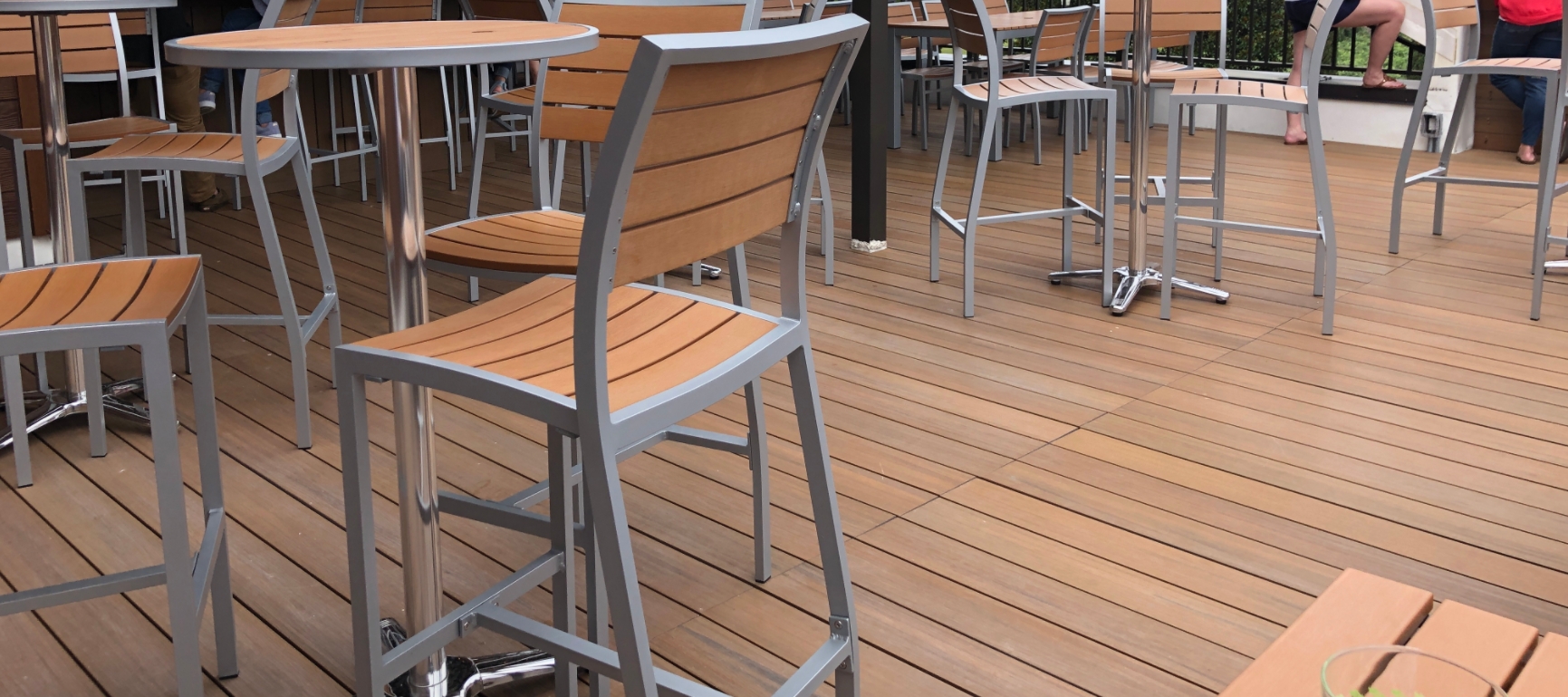In today’s hyper-competitive dining industry, every detail matters—especially your outdoor spaces. Whether it’s a charming café terrace, a vibrant rooftop bar, or a spacious restaurant patio, these outdoor dining areas can become powerful revenue generators when designed strategically. The secret? Start from the ground.
Traditional wooden decking is no longer the go-to for outdoor hospitality venues. High-maintenance, slippery when wet, and vulnerable to weather, it simply doesn’t meet modern demands. Instead, composite material decking—such as Praysun® WPC—is redefining how businesses design smarter, safer, and more stylish dining spaces. In this blog, we explore the new trends in outdoor decor and how composite decking enhances business value and customer experience, unlocking new potential for restaurants, bars, and cafés in 2025.

Outdoor dining areas must handle constant foot traffic, sudden weather changes, and rigorous cleaning cycles. But meeting these needs with traditional materials often creates more challenges than solutions.
Slip Hazards: Wood becomes dangerously slippery when wet. Cracks and warping increase trip risks—especially concerning for staff carrying hot food and drinks.
Maintenance Burden: Sanding, painting, sealing, and pest control are necessary every year. This means downtime and increased labor costs.
Short Lifespan: Wood deteriorates quickly with exposure to UV rays, rain, and temperature swings. Most wooden decks need full replacement every 5–8 years.
With a non-slip matte finish and grooved or embossed surfaces, Praysun® decking are designed for wet, high-use areas. Their low-maintenance nature saves restaurant owners up to 70% in time and costs annually. No painting, no sealing—just occasional cleaning.
Composite decking isn’t just a replacement—it’s a major upgrade. Its benefits go far beyond traditional materials, making it ideal for hospitality venues seeking both beauty and functionality.
Impact & Wear Resistance: Praysun’s high-density polymer core withstands 30% more impact than natural wood—perfect for high-traffic zones with furniture and service carts.
All-Weather Protection: No cracking in extreme temperatures from -30°C to 80°C. A UV-resistant surface maintains vibrant colors like "Latte Brown" with minimal fading for 3+ years.
Moisture & Pest Resistance: Composite materials naturally repel termites and won’t rot or swell after rain, unlike wood.
Natural Aesthetic: Choose from realistic wood grains, stone textures, and custom colors that fit your venue’s theme.
Flexible Customization: Composite boards can be cut and installed around curved patios, window sills, and even plant displays. For instance, WPC used around a bar’s perimeter can serve as a visual cue and traffic guide.
Eco-Friendly Composition: Praysun WPC uses 30–50% recycled plastic and wood waste, aligning with green business goals and EU environmental regulations.
Long-Term ROI: With a lifespan of 10–15 years and minimal upkeep, businesses save more than 40% in total costs. A 200m² restaurant could save over ¥20,000 annually on maintenance alone.
To fully leverage composite decking , businesses should think beyond just “laying the floor.” Use it to shape experiences and tell your brand story.
Dining Areas: Use slip-resistant boards (R11 rating) with warm tones and easy-clean finishes to create inviting environments that increase customer stay time.
Bars & Lounges: Go bold with stone-patterned composites and metallic hues. Pair with LED lights for evening ambiance.
Kitchen & Walkways: Grooved composite decking improves drainage and reduces slip risk from spilled water and grease.
Custom Colors & Branding: Match floor tones to your brand palette (e.g., Starbucks Green), or embed logos using mosaic styles.
Digital Integration: Place QR codes into floor panels that link to menus, reviews, or loyalty programs—turning the floor into a marketing channel.
A boutique café using Praysun WPC created a window-side “urban oasis” with built-in planter areas and elevated seating. The photogenic setup earned over 1 million social media impressions, significantly boosting foot traffic and brand exposure.
As dining spaces evolve into interactive, data-driven environments, composite materials are keeping pace:
Smart Flooring Integration: Pressure sensors track foot traffic to optimize seating layouts or trigger mood lighting as guests arrive.
Self-Heating Features: Built-in heating pads can extend outdoor dining season during cold months, increasing revenue potential.
Bio-Based Composites: Materials made from bamboo, wheat straw, or rice husks are entering the market—reducing carbon footprints and supporting “zero-waste restaurant” trends.
In the dining world, every square meter counts. Your floor is no longer just a structural layer—it’s your brand’s foundation, a key part of the customer experience, and a long-term profit multiplier.
By choosing cutting-edge solutions like Praysun® composite decking, you not only solve practical issues like safety and maintenance, but you also tap into design flexibility, environmental responsibility, and experiential branding.
In short, it’s not just a floor. It’s a strategic asset that drives your dining business forward.
praysunmaterials@gmail.com